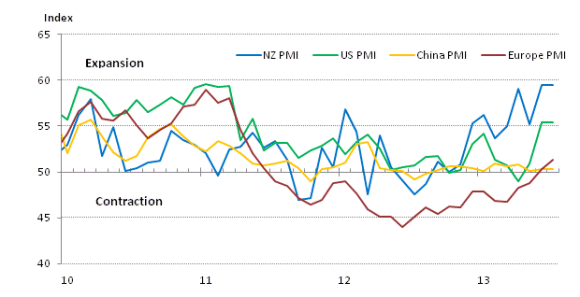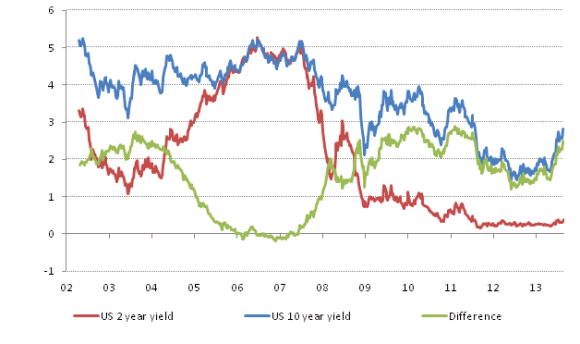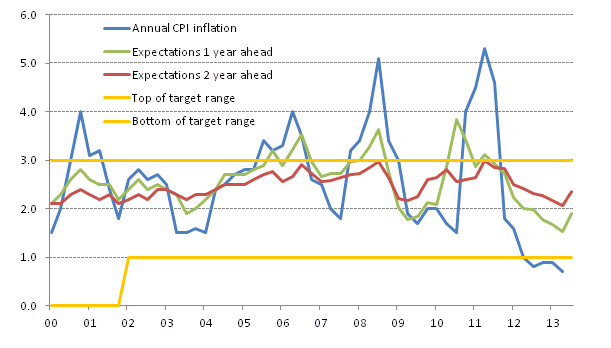Harbour: Northern autumn uncertainty
Harbour Asset Management director fixed interest, Christian Hawkesby, says the Northern Hemisphere autumn has traditionally been a time for financial panics and market wobbles and this year looks like being no different.
Thursday, September 5th 2013, 2:47PM
by Harbour Asset Management
Global macroeconomic momentum
Global bond yields continued to rise in the first half of August, as macroeconomic data pointed to ongoing economic momentum. The US 10 year yield reached as high as 2.95% in mid August – a considerable rise from the lows of 1.6% in May this year.
Purchasing Manager Indices (PMIs) point to solid economic expansion in the US (and NZ), and Europe moving out of period of economic contraction (Chart 1).
In our view, the US economy has illustrated enough momentum to justify the US Fed announcing at its upcoming September meeting that it plans to ‘taper’ QE. However, while getting the process started, we expect that they will take a cautious approach, and perhaps only scale back their asset purchases from $US85bn per month to $US70-75bn per month. Furthermore, they are likely to reiterate that the overnight US fed funds rate is likely to stay near zero for the next couple of years.
Chart 1. Global Purchasing Manager Indices (PMIs) - Manufacturing

Source: Bloomberg.
We interpret the recent rise in the US 10 year rate as the market anticipating the Fed’s announcement to taper QE. As the US economy continues to recover, we believe that the US 10 year rate may continue to drift higher. However, we think that for yields to rise much higher than 3% would require the market to no longer believe the overnight Fed Funds rate was going to be held near zero and/or for the market to become concerned about inflation. Our long-term bond yields in New Zealand continue to be at the mercy of these international developments.
Chart 2. US Yields and Slope of Yield Curve

Source: Bloomberg.
Northern autumn uncertainty
After a sharp rise at the beginning of August, the US 10 year yield consolidated around 2.75% from the middle of month, as the market began to focus on potential risks as the market moves into the northern hemisphere autumn.
Looking back through financial history, September and October have been littered with examples of financial crises and periods of acute market stress, as traders and investment managers have returned from their northern summer breaks in August. Since the onset of the GFC, we have had the run on the Northern Rock bank in 2007, the Lehmans collapse in 2008, the massive Greece budget revision in 2009, and the intensification of the European sovereign crisis in 2011. Even before the GFC, the bankruptcy of Enron in 2001, collapse of LCTM in 1998, and 1987 share market crash all occurred in the northern hemisphere autumn.
Table 1. Recent history of the northern autumn
| Event | Date | Year |
|---|---|---|
| Black Monday | 19 Oct | 1987 |
| Long Term Capital Management collapse | 23 Sept | 1998 |
| Enron restates financial accounts ahead of bankruptcy | 16 Oct | 2001 |
| Northern Rock bank run | 14 Sept | 2007 |
| Lehman Brothers collapse | 15 Sept | 2008 |
| Royal Bank of Scotland and Lloyds TSB quasi-nationalisation | 13 Oct | 2008 |
| Greece first major budget revision | 21 Oct | 2009 |
| European soverign crisis escalation | 13 Sept | 2011 |
This time around, the markets have a number of challenges to contend with, including:
- growing tensions in the Middle East that could lead to military action in Syria;
- upcoming German elections, where Merkel looks in need of new coalition partners;
- nerves about the timing of QE tapering and whether EME markets can cope with the withdrawal of stimulus; and
- uncertainty over who will become the next US Fed chairman (potentially a run-off between Janet Yellen and Lawrence Summers), and the implications for future US Fed policy.
We believe that each of these risks appears manageable for financial markets, but that collectively they have created an environment for bond and equity markets to consolidate after strong moves so far in 2013.
New Zealand’s spring uncertainty
Closer to home, the monetary policy stance of the Reserve Bank of New Zealand (RBNZ) is the main source of uncertainty. The messages from the RBNZ have been mixed in recent months. In July, in the Official Cash Rate (OCR) review, the RBNZ finally acknowledged the strong momentum in economic indicators, and flagged that the “removal of monetary stimulus will likely be needed in the future”. This was the first time since Graeme Wheeler’s appointment that they have officially moved to a tightening bias. Previously, their statements had been move even handed, opening the door to hikes or cuts.
By contrast, in a speech in August, the Governor emphasised that the NZ dollar was overvalued, hinting that they would rather avoid the headache of a higher OCR pushing the NZ dollar into even more overvalued territory. At the same, the Governor announced new ‘speed limits’ on high loan-to-value ratio (LVR) lending. While the primary purpose of the restrictions is financial stability, the RBNZ believe that the new LVR restrictions should provide more flexibility for monetary policy. In other words, they believe these new macro-prudential tools allow them to leave the OCR on hold this year.
With it becoming harder to pick the subtle shifts in the RBNZ’s communication strategy, we return to focusing more on the fundamentals over the medium term, which are telling us that:
- the NZ economy is building momentum, as evidenced by strong business and consumer confidence, elevated commodity prices and good growing conditions;
- after falling steadily through 2012, surveys of inflation expectations 2 years out have jumped to 2.4% in the most recent RBNZ survey of economists (Chart 3);
- most economists are forecasting annual headline inflation to move back up into the target range in Q3, removing some of the RBNZ’s breathing space;
- the NZ dollar has fallen around 5% below the assumption in the June Monetary Policy Statement, representing a loosening in monetary conditions; and
- against this, fixed 2 to 5 year mortgage rates have risen noticeably in recent months, representing an offsetting tightening in monetary conditions.
Chart 3. NZ Inflation expectations

Source: RBNZ
Market outlook
The northern hemisphere autumn has traditionally been a time for financial panics and market wobbles.
This year, as we moved further into August, the market became more nervous about conflict in the Middle East and whether the US Fed will be able to successfully withdraw from QE without any unintended consequences. Looking ahead to September, the German elections loom, as does the nomination of a new US Fed chairman.
We expect the US Fed will announce plans to taper QE modestly in September, while reiterating that monetary policy is still extremely stimulatory, with overnight rates near zero and continued asset purchases.
As the US economy continues to recover, we believe that the US 10 year rate may continue to drift higher in the medium term. However, in our opinion, for yields to rise much higher than 3% would require the market to doubt the Fed’s plan to keep the Fed Funds rate at zero or for the market to become concerned about inflation.
In New Zealand, the uncertainty is about how the RBNZ will weigh up the added flexibility provided by macro-prudential tools versus the widening momentum in the economy calling for tighter monetary policy.
In our view, while using macro-prudential tools may buy the RBNZ some time, OCR hikes in early 2014 are still looking likely.
Important disclaimer information
| « Tyndall: Tapering tantrums | Hamish Douglass Unplugged - Latest Video from Adviser Briefing - August 2012 » |
Special Offers
Comments from our readers
No comments yet
Sign In to add your comment
| Printable version | Email to a friend |









